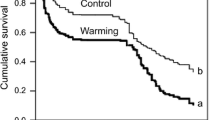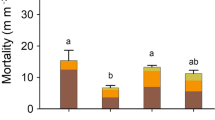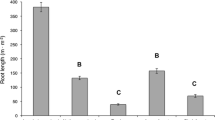Abstract
We used minirhizotrons to determine patterns of root longevity andturnover for the perennial bunchgrass Bouteloua gracilisinthe shortgrass steppe of eastern Colorado, USA. We hypothesized that rootlongevity would be partially controlled by root diameter, following previouslyobserved patterns in woody plants. In addition, we hypothesized that rootturnover would be greatest in surface soil horizons and decrease with depth dueto variation in soil moisture availability and temperature. Root longevity wascorrelated with root diameter. Median life span of roots > 0.4mm was approximately 320 days, while roots < 0.2mmhad a median life span of 180 days. There was approximately a 6%decreasein the likelihood of mortality with a 0.10-mm increase inroot diameter, controlling for the effect of depth in the soil profile. Rootlength production and mortality were highest in the upper20 cm of the soil profile and decreased with depth.However,because root length density also decreased with depth, there were nosignificantdifferences in turnover rate of root length among sampling intervals. Turnoverwas approximately 0.86 yr−1 based on root length production,while turnover was 0.35 yr−1 using root length mortality as ameasurement of flux. The imbalance between turnover estimates may be aconsequence of the time the minirhizotrons were in place prior to imaging or mayresult from our lack of over-winter measures of mortality. Our worksuggests that Bouteloua gracilis roots have complex lifehistory strategies, similar to woody species. Some portion of the root systemishighly ephemeral, while slightly larger roots persist much longer. Thesedifferences have implications for belowground carbon and nitrogen cycles in theshortgrass steppe.
Similar content being viewed by others
References
Aber J.D., Melillo J.M., Nadelhoffer K.J., McClaugherty C.A. and Pastor J. 1985. Fine root turnover in forest ecosystems in relation to quantity and form of nitrogen availability: a comparison of two methods. Oecologia 66: 317-321.
Aerts R., Bakker C., and De Caluwe H. 1992. Root turnover as determinant of the cycling of C, N, and P in a dry heathland ecosystem. Biogeochemistry 15: 175-190.
Aerts R., Berendse F., Klerk N.M. and Bakker C. 1989. Root production and root turnover in two dominant species of wet heathlands. Oecologia 81: 374-378.
Allison P.D. 1995. Survival Analysis Using the SAS System: A Practical Guide. SAS Institute, Inc., Cary, North Carolina, USA.
Ares J. 1976. Dynamics of the root system of Blue Gramma. Journal of Range Management 29: 208-213.
Bloomfield J., Vogt K. and Wargo P.M. 1996. Plant Roots: The Hidden Half. In: Waisel Y., Eshel A. and Kafkafi U. (eds), Tree Root Turnover and Senescence. Marcel Dekker, Inc., New York, pp. 363-382.
Burke I.C., Lauenroth W.K. and Milchunas D.G. 1997. Biogeochemistry of managed grasslands in central North America. In: Paul E.A., Paustian K., Elliott E.T. and Cole C.V. (eds), Soil Organic Matter in Temperate Agroecosystems. CRC Press, Boca Raton, pp. 85-102.
Burton A.J., Pregitzer K.S. and Hendrick R.L. 2000. Relationships between fine root dynamics and nitrogen availability in Michigan northern hardwood forests. Oecologia 125: 389-399.
Caldwell M.M. 1976. Root extension and water absorption. In: Lange O.L., Kappen L. and Shulze E.-D. (eds), Water and Plant Life. Springer, Berlin-Heidelberg, pp. 63-85.
Caldwell M.M. 1979. Root structure: the considerable cost of belowground function. In: Solbrig O.T., Jain S., Johnson G.B. and Raven P.H. (eds), Topics in Plant Population Biology. Columbia University Press, New York, pp. 408-427.
Cheng W., Coleman D.C. and Box J.E. 1991. Measuring root turnover using the minirhizotron technique. Agriculture, Ecosystems and Environment 34: 261-267.
Dahlman R.C. and Kucera C.L. 1965. Root productivity and turnover in native prairie. Ecology 46: 84-89.
Dodd M.B., Lauenroth W.K. and Burke I.C. 2000. Nitrogen availability through a coarse-textured soil profile in the shortgrass steppe. Soil Science Society of America Journal 64: 391-398.
Dormaar J.F. 1992. Decomposition as a process in natural grasslands. In: Coupland R.T. (ed.), Natural Grasslands: Introduction and Western Hemisphere. Elsevier, New York, pp. 121-136.
Dubach M. and Russelle M.P. 1994. Forage legume roots and nodules and their role in nitrogen transfer. Agronomy Journal 86: 259-266.
Eissenstat D.M. and Yanai R.D. 1997. The ecology of root lifespan. Advances in Ecological Research 27: 1-60.
Farrar J.F. and Jones D. 2000. The control of carbon acquisition by roots. New Phytologist 147: 43-53.
Finér L., Messier C. and De Grandpré L. 1997. Fine-root dynamics in mixed boreal conifer-broad-leafed forest stands at different successional stages after fire. Canadian Journal of Forest Research 27: 304-314.
Fitter A.H., Graves J.D., Self G.K., Brown T.K., Bogie D.S. and Taylor K. 1998. Root production, turnover and respiration under two grassland types along an altitudinal gradient: influence of temperature and solar radiation. Oecologia 114: 20-30.
Fitter A.H., Self G.K., Brown T.K., Bogie D.S., Graves J.D., Benham D. et al. 1999. Root production and turnover in an upland grassland subjected to artificial soil warming respond to radiation flux and nutrients, not temperature. Oecologia 120: 575-581.
Franklin J.F., Bledsoe C.S. and Callahan J.T. 1990. Contributions of the long-term ecological research program. BioScience 40: 509-523.
Friend A.L., Coleman M.D. and Isebrands J.G. 1994. Carbon allocation to root and shoots ystems of woody plants. In: Davis T.D. and Hassig B.E. (eds), Biology of Adventitious Root Formation. Plenum Press, New York, pp. 245-273.
Gaudinski J.B., Trumbore S.E., Davidson E.A. and Zheng S. 1998. Soil carbon cycling in a temperate forest:radiocarbon-based estimates of residence times, sequestration rates and partitioning of fluxes. Biogeochemistry (in press).
Gholz H.L., Hendry L.C. and Cropper W.P. 1986. Organic matter dynamics of fine roots in plantations of slash pine (Pinus elliotti) in north Florida. Canadian Journal of Forest Research 16: 529-538.
Gill R.A., Burke I.C., Milchunas D.G. and Lauenroth W.K. 1999. Relationship between root biomass and soil organic matter pools in the shortgrass steppe of eastern Colorado: Implications for decomposition through a soil profile. Ecosystems 2: 226-236.
Gill R.A. and Jackson R.B. 2000. Global pattern of root turnover for terrestrial ecosystems. New Phytologist 147: 13-31.
Gordon W.S. and Jackson R.B. 2000. Nutrient concentrations in fine roots. Ecology 81: 275-280.
Hansson A., Aifen Z. and Andren O. 1995. Fine root production and mortality in degraded vegation in Horquin sandy rangeland in inner Mongolia, China. Arid Soil Res. Rehab 9: 1-13.
Hendrick R.L. and Pregitzer K.S. 1992. The demography of fine roots in a northern hardwood forest. Ecology 73: 1094-1104.
Hendrick R.L. and Pregitzer K.S. 1993. Patterns of fine root mortality in two sugar maple forests. Nature 361: 59-61.
Hendrick R.L. and Pregitzer K.S. 1996a. Temporal and depth-related patterns of fine root dynamics in northern hardwood forests. Journal of Ecology 84: 167-176.
Hendrick R.L. and Pregitzer K.S. 1996b. Applications of minirhizotrons to understand root function in forests and other natural ecosystems. Plant and Soil 185: 293-304.
Hendrick R.L. and Pregitzer K.S. 1997. The relationship between fine root demography and the soil environment in northern hardwood forests. Ecoscience 4: 99-105.
Hook P.B. and Lauenroth W.K. 1994. Root system response of a perennial bunchgrass to neighbourhood-scale soil water heterogeneity. Journal of Ecology 82: 485-494.
Jackson R.B. and Caldwell M.M. 1989. The timing and degree of root proliferation in fertile-soil microsites for three cold-desert perennials. Oecologia 81: 149-153.
Joslin J.D. and Wolfe M.H. 1999. Disturbances during minirhizotron installation can affect root observation data. Soil Science Society of America Journal 63: 218-221.
Kramer P.J. and Boyer J.S. 1995. Water Relations of Plants and Soils. Academic Press, San Diego.
Lauenroth W.K. and Milchunas D.G. 1992. Short-grass steppe. In: Coupland R.T. (ed.), Natural Grasslands: Introduction and Western Hemisphere. Elsevier, New York, pp. 183-226.
Lauenroth W.K. 2000. Methods of estimating belowground net primary production. In: Sala O.E., Jackson R.B., Mooney H.A. and Howarth R.W. (eds), Methods in Ecosystem Ecology. Springer, New York, pp. 58-71.
Lauenroth W.K. and Gill R.A. 2002. Turnover of root systems. In: Visser E.J.W. et al. (ed.), Root Ecology. (submitted).
Leetham J.W. and Milchunas D.G. 1985. The composition and distribution of soil microarthropods in the shortgrass steppe in relation to soil water, root biomass, and grazing by cattle. Pedobiologia 28: 311-325.
Levan M.A., Ycas J.W. and Hummel J.W. 1987. Light leak effects on near surface soybean rooting observed with minirhizotrons. In: Taylor H.M. (ed.), Minirhizotron Observation Tubes: Methods and Applications for Measuring Rhizosphere Dynamics. American Society of Agronomy, Madison, WI, pp. 89-98.
Majdi H. 1996. Root sampling methods-applications and limitations of the minirhizotron technique. Plant and Soil 185: 255-258.
Marshall J.D. and Waring R.H. 1985. Predicting fine root production and turnover by monitoring root starch and soil temperature. Canadian Journal of Forest Research 15: 791-800.
McClaugherty C.A., Aber J.D. and Melillo J.M. 1984. Decomposition dynamics of fine roots in forested ecosystems. Oikos 42: 378-386.
Milchunas D.G. and Lauenroth W.K. 1992. Carbon dynamics and estimates of primary production by harvest, 14C dilution, and 14C turnover. Ecology 73: 593-607.
Nadelhoffer K.J., Aber J.D. and Melillo J.M. 1985. Fine roots, net primary production, and soil nitrogen availability: a new hypothesis. Ecology 66: 1377-1390.
Nambiar E.K.S. 1987. Do nutrients retranslocate from fine roots? Canadian Journal of Forest Research 17: 913-918.
Pagès L. and Bengough A.G. 1997. Modelling minirhizotron observations to test experimental procedures. Plant and Soil 189: 81-89.
Parton W.J. and Greenland D. 1987. Central Plains Experimental Range. In: Greenland D. (ed.), The Climates of the Long-Term Ecological Research Sites. University of Colorado Press, Boulder, Colorado, pp. 23-29.
Picard D. 1979. Evaluation of the organic matter supplied to the soil by the decay of the roots of an intensively managed Panicum maximum sward. Plant and Soil 51: 491-501.
Pregitzer K.S., Kubiske M.E., Yu C.K. and Hendrick R.L. 1997. Relationship among root branch order, carbon, and nitrogen in four temperate species. Oecologia 111: 302-308.
Pregitzer K.S., Laskowski M.J., Burton A.J., Lessard V.C. and Zak D.R. 1998. Variation in sugar maple root respiration with root diameter and soil depth. Tree Physiology 18: 665-670.
Sala O.E., Lauenroth W.K. and Parton W.J. 1992. Long-term soil water dynamics in the shortgrass steppe. Ecology 73: 1175-1181.
Scheu S. and Schauermann J. 1994. Decomposition of roots and twigs: Effects of wood type (beech and ash), diameter, site of exposure and macrofauna exclusion. Plant and Soil 163: 12-34.
Sims P.L. and Singh J.S. 1978. The structure and function of ten western North American grasslands. III. Net primary production, turnover and efficiencies of energy capture and water use. Journal of Ecology 66: 573-597.
Steele S.J., Gower S.T., Vogel J.G. and Norman J.M. 1997. Root mass, net primary production and turnover in aspen, jack pine, and black spruce forests in Saskatchewan and Manitoba, Canada. Tree Physiology 17: 577-587.
Weaver J.E., Houghen V.H. and Weldon M.D. 1935. Relation of root distribution to organic matter in prairie soil. Botanical Gazette 96: 389-420.
Wells C.E. and Eissenstat D.M. 2002. Defining the fine root: Marked differences in survivorship among apple roots of different diameters. Ecology (in press).
Wiersum L.K. 1958. Density of root branching as affected by substrate and separate ions. Acta Botanica Neerlandica 7: 174-190.
Author information
Authors and Affiliations
Rights and permissions
About this article
Cite this article
Gill, R.A., Burke, I.C., Lauenroth, W.K. et al. Longevity and turnover of roots in the shortgrass steppe: influence of diameter and depth. Plant Ecology 159, 241–251 (2002). https://doi.org/10.1023/A:1015529507670
Issue Date:
DOI: https://doi.org/10.1023/A:1015529507670




